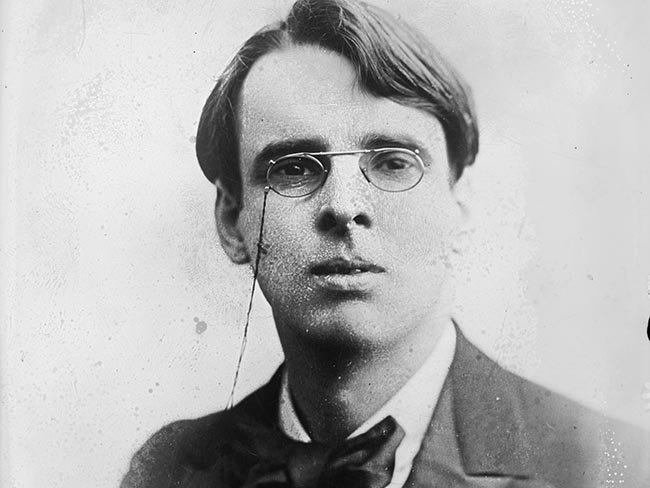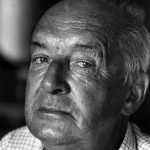William Butler Yeats was one of the major English-language poets of the XXth century. He got the Nobel Prize for Literature in the 1923.
Born: June 13, 1865
Sandymount, Dublin, Leinster, Ireland
Poet, playwright
Being a poet of a modernistic epoch, he followed anti-avant-garde position in the art. He never tried to run ahead of progress. To ignore it cold-bloodedly, to walk out of step, to hold one’s own, to look up the future in the past was a matter of honor for him.
Biography of William Butler Yeats
William Butler Yeats was born on the 13th of June, 1865. The father of the poet, John Butler Yeats, got legal education, but, when the son was two years old, decisively separated from the advocate world and set out to London to study painting. He became a portraitist.

William’s young brother was the known Irish artist Jack Butler Yeats. In the 1880, the Yeats returned to Ireland and settled in the Dublin suburb. In Dublin, William Yeats graduated from the school and entered Metropolitan School of Art with the father’s approval.
Very early, Yeats’s interest in occultism was shown. Already in the art school, he got acquainted with George Russell, a future poet and occultist, who wrote under a pen- name A. Е. They and some other people founded the Hermetic society for study of magic and east religions under the chairmanship of Yeats. In the middle of the1880s, he shortly joined the theosophical society, but soon he was disappointed with it.
William Butler Yeats life
On the 30th of January, 1889, Yeats got acquainted with Maud Gonne, who became his love for a long while. She was an active participant of independence movement of Ireland and involved Yeats in the political struggle. Yeats did not give up his interest for occult disciplines, for example, in the 1890, he entered into the Order of the Golden Dawn founded shortly before by his acquaintance Mack-Gregor Meters.
The beginning of the twentieth century was marked by Yeats’s heightened interest in the theater. He took active part in the work of the first Irish national “Theater of the Abbey” and he soon became its perennial director. Yeats wrote several plays, on the style of which the Japanese Theater No had a noticeable influence.

In the spring of the 1917, Yeats bought his famous “tower” mentioned many times in his late works as a symbol of traditional values and spiritual development. This was a homestead with a neglected Normandy watchtower situated in the Irish county Galway. He placed many forces to make his ancestral nest of this tumbledown construction. It was because in the autumn of the same 1917 year, he marries after all. The marriage with twenty-five-year old Georgie Hyde-Lees turned out successful, the couple had two children, a son and a daughter.
In the 1923, the Nobel prize for literature was awarded to Yates.
He died in the hotel in Menton, France in the 1939. He was buried also in France, but in the 1948, his ashes were taken across to Ireland.
Creative work of William Butler Yeats

William Yeats began to write poems early and his talent was noticed fairly quickly.
In the 1885, Yeats got acquainted with John O’Leary, a member of an Irish secret “Fenians” society, which after perennial confinement and expulsion had returned to Dublin. Under the influence of the new acquaintance, Yeats began to write poems and articles in a patriotic manner, numerous images of the ancient Irish culture of Celts appeared in his poetics.
In the 1899, the collection of poems of William Butler Yeats “The Wind among the Reeds” was published, it was the main achievement of the early stage of his creative work, based on critics` opinion. The imagery of Yeats’s poetry was saturated in that time by characters of Celtic mythology and folklore. Yeats got the reputation of a poet “of a Celtic twilight”, the time of the decline of national culture of Ireland, looking for strength only in the revival of forgotten legacy of the past.
In the beginning of the XXth century, Yeats got acquainted with the then beginning modernist poet Ezra Pound, who had certain influence on the style of Yeats.
Yeats did not give up his enthusiasm for occultism. In the 1925, the distillate of his perennial thoughts on the topic appeared– the book “Vision”, where he connected the stages of development of the human spirit with phases of the Moon. In the more mature age, Yeats suffered the second birth as a poet and he published two poem collections, which became the top of his creative development – this “The Tower” (1928) and “The Winding Stair” (1933).
William Butler Yeats poems
One can say, in the epoch of the coming materialism, Yates represented an outpost with a front line moved out far forward of the stubbornest and habitual idealism.
In the epoch, when pragmatism tried to make a poet an inventive person, a leisure worker, to drive a cricket of art on the perch intended for it, Yeats’s Archimedean effort to reverse the world and confirm it on an intangible fulcrum deserves admiration.
Here is one of the examples of his unique works. The poem “The Second Coming” by William Butler Yeats was written in the 1920. The poet begins with the image of a falcon hovering about in the sky, far away from a hunter. The bird continues to hover and gyres further and further away from the falconer. It is a metaphor, which signifies the youth, who have given up traditions of their fathers and forefathers for the new art, literature and music. There is one more strong image of “The Second Coming”: it is Sphinx. Thus, the author denotes the Second Coming of Christ. This poem is an enigma, as the poet finishes it by a question. However, it contains some allusions to crack the mystery in order to make readers think over the answer on their own.
William Butler yeats famous works
- Brown Penny
- He Wishes For The Cloths Of Heaven
- A Song From ‘The Player Queen’
- The Second Coming
- September 1913
- An Irish Airman Forsees His Death
- The Stolen Child
- Sailing To Byzantium
- The Lake Isle Of Innisfree
- Under Ben Bulben
Facts about William Butler Yeats
- while Yeats’ poetry was an instant success, it was only in 1923, at the age of 58, that he was awarded the Nobel Prize in Literature
- Yeats’ interest in spiritualism, occultism, and astrology started when he was very young and lasted all his life
- his most known muse was the English heiress Maud Gonne, whom he proposed in 1899, 1900, 1901, and 1916 – without success
- in 1916, Yeats, who was then 51 years old and determined to produce an heir, married 25-year-old Georgie Hyde-Lees, with whom they later had two children together
- almost at 70, he went through the Steinach operation and started a string of intimate relations with younger women
- Yeats belonged to Symbolist poets
- in 1989, a statue of Yeats was created in Sligo town.
William Butler Yeats death: January 8, 1939 in Menton



